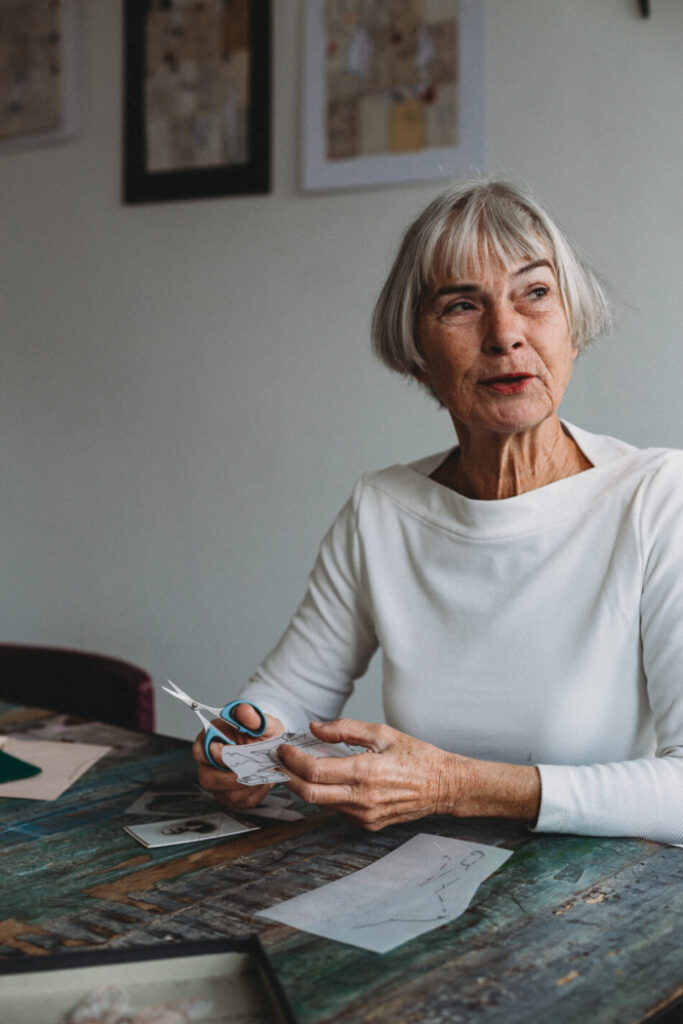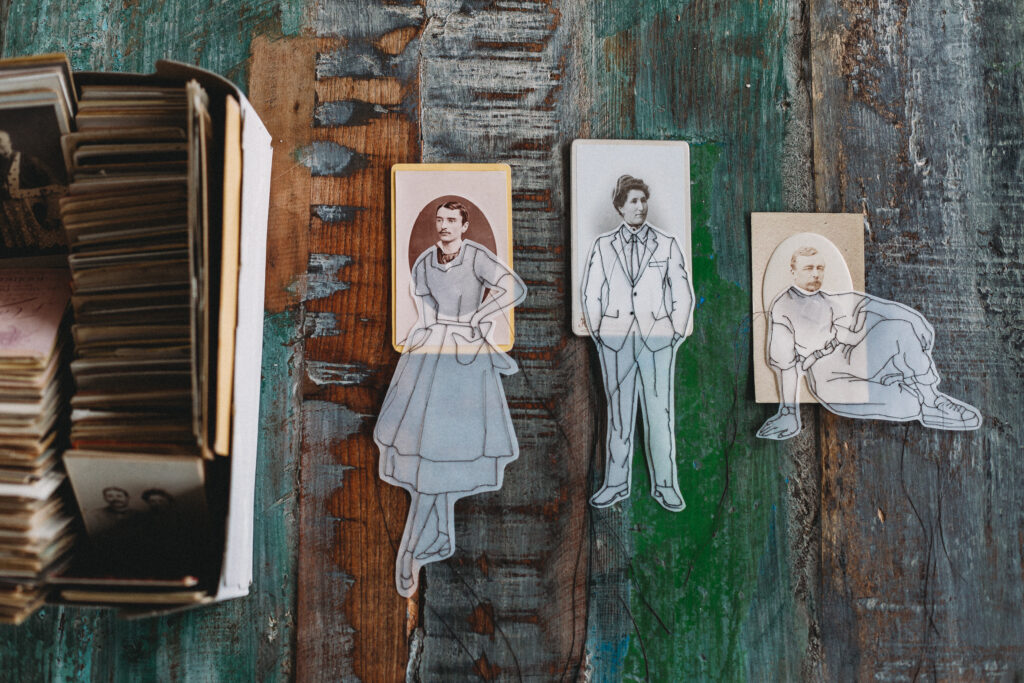Marjolein Burbank

Marjolein Burbank lives and works from her home atelier in the Hague, in the Netherlands. Marjolein is a textile artist and the majority of her work leans toward textile and threaded pieces, but her work also spans (threaded) collage and assemblage.
She has travelled and lived abroad in Panama, Peru, Bolivia, Austria and Thailand, always accompanying her husband due to his postings and moving their family (she has two daughters).
“When we lived in these countries, I was an ex-pat, a position that comes with privilege. But suddenly I was in a new country, and I did not have a work permit, I love travelling and exploring, and meeting people from other cultures. Being abroad taught me to look at people and my own culture with fresh eyes, but the expatriate lifestyle did not suit me. I felt that my husband’s professional role determined my position and I know it is not necessarily like that nowadays, but this is how I experienced life as an ex-pat.”
With a professional background in psychiatric care, Marjolein had been working in a psychiatric ward in the Netherlands as an occupational therapist in an institution for people with long-term sickness. During her time abroad and without a job of her own, she picked up quilting. “I would make wall hangings based on portraits of local people I had met or photographed.
I couldn’t get a job in my field of expertise because I had no rights, I saw what happened to other partners and women were left behind in a country, helplessly. It was a pleasure to live in a foreign country for a longer period and to learn about their cultures and their traditions. However, I felt that I lost some rights and was simply fulfilling the role of ‘wife’. I don’t like an environment of hierarchy that is determined by your husband's position. I followed my husband and then came feminism.”
Marjolein is a very active artist and has a high level of production. I ask her how she does this. “ I just sit down at 9 o’clock in the morning and start working. By the end of the day, I feel that I have accomplished something. It also helps that my partner leaves the house and goes to work at his home, I have my own space, and I am very content to spend the day on my own working.
We’re sitting at her dining table in her open-plan living space. Her apartment is above the entranceway to a courtyard, a small group of former workers' houses that feels like a little community within the neighbourhood. The floor-to-ceiling windows let in plenty of light and on a day like today the windows are open letting in the fresh autumn air. We drink cappuccino, and I ask my first question “Who is Marjolein Burbank?”. She responds with a deep sigh. “Ha, I don’t know either. My background is in textile art. I have two daughters. I’ve worked in psychiatric care. I followed my husband. And out of all this came feminism.” All of this in a very matter-of-fact response.

Could you tell me about having a family and finding time to make art?
When your kids have left home, there is more space to find yourself again. I like having the freedom to fill in the days as I want to. Having said that, I have two strong and very vocal daughters who I am proud of. The eldest studied gender studies. Unfortunately, she also went through a burnout. Both things introduced me to new issues and themes in society. My youngest daughter is adopted. Thanks to her I experienced things that opened my eyes. When we lived abroad, there were comments from people that left so much judgement and racism toward my daughter. But she is my daughter, regardless of the colour of her skin! I experienced white privilege, and I saw how it works. I felt the effects of it deeply, and these observations and their underlying issues became the subjects of my work. I started to include social commentary in my work, sometimes by adding text to the textile art.
Do you not need others to hear your voice anymore?
Look I’ve always got something to say, I’m the person that shouts “Get off the pavement!” to cyclists. I still comment on society in my work. But perhaps in a less obvious way. My work is more accessible, maybe people don't see the social commentary anymore, and that doesn't matter to me, I put it in there anyway because I want to say it. I still have things to say, but nowadays I say them with a touch of humour. My work is tongue-in-cheek.
Is your work today still your way of processing what you experienced then or is it a response to current affairs?
Well, I think I have a luxury position. I live in a house that's factually too big for just one person (now that my daughters have moved out). I know that I can’t change the world. Does the Pride flag help? Does it change anything? Yes, it does, it is about acceptance. I understand that I am a global citizen and I could do something. For example, look at my works of men in dresses. These men in dresses (and women in trousers) are my tiny grain of sand, my contribution to acceptance.
Or if you look at the “winged people”, the vleugeldingen (“wingthings”) that I make, people think they are angels. But my idea behind it is that if you look beyond the superficial layer, past the surface, all people are weird, special, complex or quirky. People are not boring. I am interested in complicated people and the complex side of humans. Everyone is interesting.

Do you come from an artistic family?
Not particularly and I did not go to the art academy. I followed a Montessori education, and we were encouraged to make gifts for our family members. At primary school I did what I was told at school but by the age of twelve, I didn't do what I was told anymore because by then I thought I knew best. And I did know what I needed best. My mother was headstrong. I probably got that from her. But she saved me from the fate of the huishoudschool (domestic school). If you didnt make it to a certain academic level you were destined to learn how to become a homemaker. Mum saved me by making sure I could continue Montessori education and I am certain it made me who I am. I think my mother was a feminist. It just wasn't called feminism then. It was called standing up for yourself.
"I love looking in containers and the free libraries, and I buy photos at the vintage market here in The Hague. Nearly everything I use is re-used."
Let’s talk about your work. You’re a textile artist.
Yes. I treat paper like textiles. Look, I just ordered these coupons from the States, (shows me a box of gasoline coupons) I don't use glue, but I embroider straight through the paper. It’s a vintage photo, the outline of a car, some gasoline vouchers and a title referring to the rise in gasoline prices. That’s it.
I remember my mother used to make clothes for us, I was used to seeing her work with a sewing machine. At primary school, the girls were expected to join the sewing class and the boys the woodwork class. I wanted to join the woodwork class, but it wasn’t allowed. I think I was permitted to do some soldering and carpentry. In high school, I was the first student ever to take textiles as a final-year exam.
So you're a pioneer!
No, I just want to decide things for myself, and I don't want others to tell me what to do (she said with a rebellious smirk).
Where do you get your material from?
Well…for example, found cardboard, I love it! And I love looking in containers and the free libraries, and I buy photos at the vintage market here in The Hague. Nearly everything I use is re-used. I’ve done some work with modern photos, but I’m not as satisfied with those pieces. Old photos already have charm, I much prefer old photos.
You make a lot of art, but you still have a playful approach to your work.
Yes, I want to be careful that I don't keep repeating myself. Budget crisis, gender issues, oil prices, environmental issues, quite often there is something that I have the desire to comment on, so I will look for articles and research a theme (i.e., the benzine crisis in France) and find words that I like and use them to tell a visual story. I have come to accept that I am a generalist, not a specialist. I get the most likes on social media on my cross-dressing figures, but I don't want to become a production factory of those (just because they are popular). I want to make surprising things and things in the news, and things from my heart.

How does making art bring you joy?
It’s the surprise of making something and also the contentment of making it. And I enjoy feeling like my head is full.
So… you like that your head feels full?!
Yes! Not occupied by the drag of the next load of laundry or the shopping that needs to be done, but instead, my head is full of ideas and figuring out how I am going to make something, and the excitement of starting something new.
"I still have things to say, but nowadays I say them with a touch of humour. My work is tongue-in-cheek."
Do you find it hard to sell your pieces?
No not at all, it's the pleasure that comes with making something. A bigger piece takes a maximum of five hours. And tomorrow I have another 5 hours.
I really like selling my work, it’s a compliment that people value my work and are willing to pay for it. I’ve had people (in the U.S.) tell me I should have higher prices, but I ask what I feel comfortable with and what I think is suitable.
When you buy work from other artists how do you determine what you are willing to pay?
I instantly know if I want a piece when I see it. In Thailand, I visited a lot of galleries and bought a lot of art. I love hand-crafted work, work that is made by hand. It’s what I make too. Handmade work touches me, and that's what I appreciate.
I think there is a huge amount of input and output in your head, your energy is incredible.
Yes, I am very chaotic. I am dreadful.
My mother used to say that I should do yoga, I didn't want to, but she was right in a way, and eventually, I found relaxation in making things with my hands. Embroidery is my daily work. Since we are coming out of corona and lockdowns and there are social commitments and openings at galleries again, I honestly feel like sometimes I’d rather be at home making things. I am very content with my life.
This article was featured in issue 15 of Contemporary Collage Magazine. All photos by Evamaria Kulovits ©